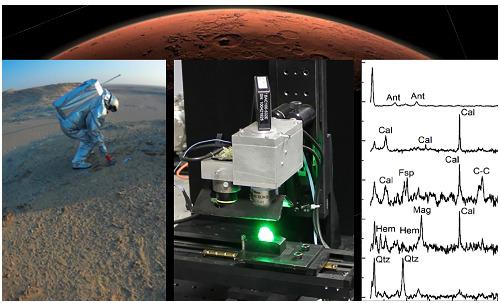当前位置:
X-MOL 学术
›
J. Raman Spectrosc.
›
论文详情
Our official English website, www.x-mol.net, welcomes your feedback! (Note: you will need to create a separate account there.)
Raman characterization of terrestrial analogs from the AMADEE‐18 astronaut simulated mission using the ExoMars RLS simulator: Implications for Mars
Journal of Raman Spectroscopy ( IF 2.5 ) Pub Date : 2020-11-09 , DOI: 10.1002/jrs.6023 Emmanuel Alexis Lalla 1 , Menelaos Konstantinidis 1, 2 , Guillermo Lopez‐Reyes 3 , Michael G. Daly 1 , Marco Veneranda 3 , José A. Manrique 3 , Gernot Groemer 4 , Jorge L. Vago 5 , Fernando Rull 3
Journal of Raman Spectroscopy ( IF 2.5 ) Pub Date : 2020-11-09 , DOI: 10.1002/jrs.6023 Emmanuel Alexis Lalla 1 , Menelaos Konstantinidis 1, 2 , Guillermo Lopez‐Reyes 3 , Michael G. Daly 1 , Marco Veneranda 3 , José A. Manrique 3 , Gernot Groemer 4 , Jorge L. Vago 5 , Fernando Rull 3
Affiliation

|
Between February 1 and February 28, 2018, the Austrian Space Forum, in cooperation with research teams from 25 nations, conducted the AMADEE‐18 mission—a human‐robotic Mars expedition simulation in the Dhofar region in the Sultanate of Oman. As a part of the AMADEE‐18 simulated Mars human exploration mission, the Remote Science Support team investigated the Dhofar area (Oman) to qualify it as a potential Mars analog site. The motivation of this research was to study and register selected samples collected by the analog astronauts during the AMADEE‐18 mission with the European Space Agency (ESA) ExoMars Raman Laser Spectrometer (RLS) simulator, compare the results with standard laboratory measurements, and establish the implication of the results to the future ESA ExoMars mission. The Raman measurements identified minerals such as carbonates (calcite and dolomite), feldspar and plagioclase (albite, anorthite, orthoclase, and sanidine), Fe‐oxides (goethite, hematite, and magnetite), and Ti‐oxide (anatase), each relevant to planetary exploration. As we have presented here, Raman spectroscopy is a powerful tool for detecting the presence of organic molecules, particularly by analyzing the principal vibration of CC and CH bonds. It has also been shown that portable Raman spectroscopy is a relevant tool for in situ field studies such as those conducted during extra‐vehicular activities (EVA) in simulated missions like the AMADEE‐18 and the future AMADEE‐2020 campaign.
中文翻译:

使用ExoMars RLS模拟器对AMADEE-18宇航员模拟任务中的地面类似物进行拉曼表征:对火星的影响
在2018年2月1日至2月28日之间,奥地利太空论坛与来自25个国家的研究团队合作进行了AMADEE-18任务,这是在阿曼苏丹国Dhofar地区进行的人类机器人火星探险模拟。作为AMADEE-18模拟火星人类探索任务的一部分,远程科学支持小组对Dhofar地区(阿曼)进行了调查,以使其有可能成为火星模拟地点。这项研究的目的是在欧洲航天局(ESA)ExoMars拉曼激光光谱仪(RLS)模拟器上研究和记录模拟宇航员在AMADEE-18任务期间收集的选定样本,将结果与标准实验室测量结果进行比较,并确定结果对未来ESA ExoMars任务的影响。拉曼测量确定了诸如碳酸盐(方解石和白云石),长石和斜长石(方铁,钙长石,正长石和山铁矿),铁氧化物(针铁矿,赤铁矿和磁铁矿)和钛氧化物(锐钛矿)等矿物。进行行星探索。正如我们在这里介绍的那样,拉曼光谱法是检测有机分子存在的强大工具,特别是通过分析C的主振动 C和CH键。研究还表明,便携式拉曼光谱仪是现场实地研究的重要工具,例如在AMADEE-18和未来的AMADEE-2020战役等模拟任务中进行车外活动(EVA)时进行的那些研究。
更新日期:2020-12-10
中文翻译:

使用ExoMars RLS模拟器对AMADEE-18宇航员模拟任务中的地面类似物进行拉曼表征:对火星的影响
在2018年2月1日至2月28日之间,奥地利太空论坛与来自25个国家的研究团队合作进行了AMADEE-18任务,这是在阿曼苏丹国Dhofar地区进行的人类机器人火星探险模拟。作为AMADEE-18模拟火星人类探索任务的一部分,远程科学支持小组对Dhofar地区(阿曼)进行了调查,以使其有可能成为火星模拟地点。这项研究的目的是在欧洲航天局(ESA)ExoMars拉曼激光光谱仪(RLS)模拟器上研究和记录模拟宇航员在AMADEE-18任务期间收集的选定样本,将结果与标准实验室测量结果进行比较,并确定结果对未来ESA ExoMars任务的影响。拉曼测量确定了诸如碳酸盐(方解石和白云石),长石和斜长石(方铁,钙长石,正长石和山铁矿),铁氧化物(针铁矿,赤铁矿和磁铁矿)和钛氧化物(锐钛矿)等矿物。进行行星探索。正如我们在这里介绍的那样,拉曼光谱法是检测有机分子存在的强大工具,特别是通过分析C的主振动 C和CH键。研究还表明,便携式拉曼光谱仪是现场实地研究的重要工具,例如在AMADEE-18和未来的AMADEE-2020战役等模拟任务中进行车外活动(EVA)时进行的那些研究。



























 京公网安备 11010802027423号
京公网安备 11010802027423号